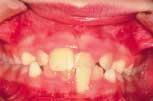Insiders
by Frederick G. Preis, DDS
Drs. Rebecca Poling and Mary Barkley offer a unique perspective to oral health team members. Both doctors worked as dental hygienists before they became orthodontists. They are keenly aware of the importance of communication between orthodontists and hygienists.
Currently, the Commission on Dental Accreditation, sponsored by the American Dental Association, doesn't require courses on orthodontics in the curriculum of dental hygiene schools. Consequently, most dental hygiene schools devote little time to dentistry's oldest specialty, orthodontics - an important component of optimal dental health. Without treatment, orthodontic problems may lead to chipped teeth, tooth decay, and gum disease, which may lead to bone destruction.
"Many dental hygienists are eager to learn more about orthodontics," says Dr. Barkley, who has an orthodontic practice in Chelsea, Mich., a suburb of Detroit. Dr. Poling, who practices in Anchorage, Alaska, agrees. The reason is that hygienists want to enhance their skills and knowledge in caring for their patients.
"Hygienists are caring, smart, and detail-oriented professionals," says Dr. Poling.
To help enhance communication between dental hygienists and orthodontists, the two doctors advise their colleagues in orthodontic practice to be proactive in establishing relationships with hygienists of referring general dentists' offices. One of the primary outcomes of such efforts, they believe, will be improvement in orthodontic services and information provided to patients.
Dental hygienists are in an important position. They are frequently the first person to see a patient and the first to recognize that a patient has an orthodontic problem.
Orthodontists can provide hygienists with detailed information that will help them communicate to their patients how orthodontic treatment can play an important role in long- and short-term oral health. In addition, learning more about orthodontics provides dental hygienists with an enhanced understanding of orthodontic issues. If a patient expresses concerns about his or her bite or appearance, the hygienist can help meet the patient's needs by making an orthodontic referral in conjunction with the dentist. Frequently, patients have an orthodontic problem of which they aren't even aware. That's when a hygienist has an opportunity to provide a valuable service to the patient. By calling the patient's attention to the condition, and alerting the patient's dentist, the patient can be advised to seek treatment to resolve the problem.
As a young dental hygienist, Dr. Poling says she didn't realize the tremendous impact that orthodontic treatment could have on a patient.
"I took my smile for granted," says Dr. Poling. "I didn't really understand the psychological ramifications that ugly teeth and a bad bite can have on someone's self-image. Of course, there are health benefits to having straight teeth and a good bite. But I've been amazed to learn what a difference having a beautiful smile can make in someone's life."
Dr. Barkley agrees. "When you are in dental hygiene school, there is so much going on," she says. "I know I didn't absorb as much as I could have about orthodontics.
"I wish that, as a dental hygiene student, I had learned more about how malocclusions affect dental health," adds Dr. Barkley, who conducts a seminar on orthodontics for hygienists in her area.
Drs. Poling and Barkley recommend that hygienists visit the American Association of Orthodontists (AAO) Web site at www.braces.org to learn more about orthodontics and problem bites. They also recommend that dental hygienists interested in learning more about orthodontics read some general information textbooks, such as Robert E. Moyer's Handbook on Orthodontics. The book is written for dental students and gives a thorough overview of orthodontic diagnosis and treatment. Another excellent resource is the AAO's book, Straight Facts About Orthodontics, available through members of the AAO.
"Personally, I would be flattered if a hygienist called to ask if she or he could visit for a few hours to learn more about orthodontics."
For Drs. Barkley and Poling, the evolution from dental hygienist to orthodontist has been a hard but rewarding road. "It has been a fun ride," says Dr. Barkley. "I've been so fortunate to have worked in two enriching professional fields."
"Orthodontics and dental hygiene have a lot in common," says Dr. Poling. "Delivering results, providing super quality service - all in a team setting - is a real challenge. Like dental hygiene, orthodontics has been very satisfying."
After completing the University of Detroit-Mercy's orthodontic residency program in 1986, Dr. Barkley opened her current practice, a five-person office with an office manager, a receptionist, two clinicians (including Barkley) and a sterilization coordinator.
Each year, Dr. Barkley hosts a seminar for dental hygienists from local dental offices. Her practice has thrived, in part, because of her close relationship with local dental hygienists. She credits the high number of referrals from dentists to her yearly seminar for dental hygienists.
"I have found that the more familiar dental hygienists are with my office, the more comfortable they are about sending their patients to my practice," says Dr. Barkley. "And even though I've been an orthodontist for a long time now, I'm still a dental hygienist at heart."
After receiving her dental hygiene degree, Dr. Poling worked as an instructor at the University of Maryland, teaching dental students how to run an office and manage dental hygienists. Her accomplishments and expertise attracted the attention of Anchorage Community College, which was starting its own dental hygiene program. She soon found herself at Anchorage Community College, where she wrote the school's dental hygiene curriculum, designed the clinic, hired the faculty and directed dental hygiene classes whose members routinely finished near the top in national board exams.
Two years later, Dr. Poling left Anchorage Community College for the University of Washington, where she earned her dental degree in 1981 and her orthodontic degree in 1984. Dr. Poling's state-of-the-art practice in Anchorage features seven staff members, including an experienced dental hygienist.
"I have an understanding of the challenges of being a dental hygienist and what hygienists are expected to accomplish," says Dr. Poling.
Dr. Frederick Preis is immediate past president of the American Association of Orthdontists. He practices in Bel Air, Md.
How pediatric patients may benefit from orthodontic check-ups
The American Association of Orthodontists recommends that all children receive orthodontic check-ups no later than age 7.
• An early orthodontic check-up enables an orthodontist to determine whether permanent teeth will be crowded and result in bite problems. If that is the case, early orthodontic treatment may preserve or increase space for erupting permanent teeth. In addition, for some children, early orthodontic attention may help correct harmful oral habits or even lower the risk of trauma to protruded front teeth.
• Overcrowding may require early extractions to prevent teeth from erupting ectopically and make it easier for the child to maintain excellent oral hygiene.
• Anterior crossbites are detrimental to a child's dental health and may need to be treated early to prevent future problems and allow for proper function and development. (Figure 1)
• Posterior crossbite requires early correction to increase arch length and lessen the possibility of impacted canines or future crowding, and decreases cheek-biting episodes. (Figure 2)
• Controlling harmful habits and allowing for proper interarch alignment provides for correct early development of the teeth, jaws, lip relation and tongue position, as well as setting the stage for normal eating and speech production. (Figures 3 and 4)
These examples are only a few of the reasons why the AAO recommends an orthodontic check-up no later than age 7.





